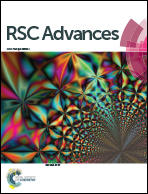Catalyst free decarboxylative trichloromethylation of aldimines†
Abstract
A catalyst free decarboxylative trichloromethylation of imines to afford different trichloromethyl sulfonyl and sulfinyl amines has been presented. Only DMSO as a solvent at room temperature was necessary to provide the corresponding products in good to high isolated yields. A highly diastereoselective version was carried out, leading to the sulfinylimine with good yield and near perfect diastereoselectivity. Regarding the reaction profile, ATR-FTIR spectroscopy was employed to support the entire mechanism and also to provide details on the trichloroacetate salts behavior against electrophiles and in the presence of different solvents.


 Please wait while we load your content...
Please wait while we load your content...